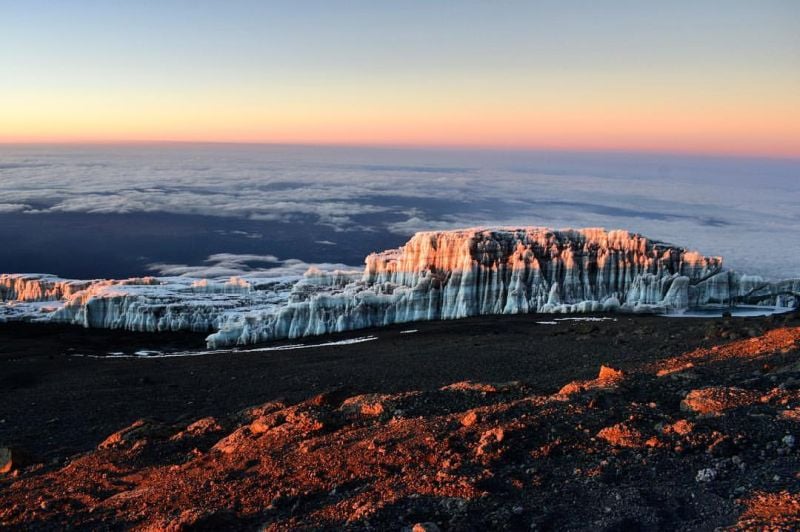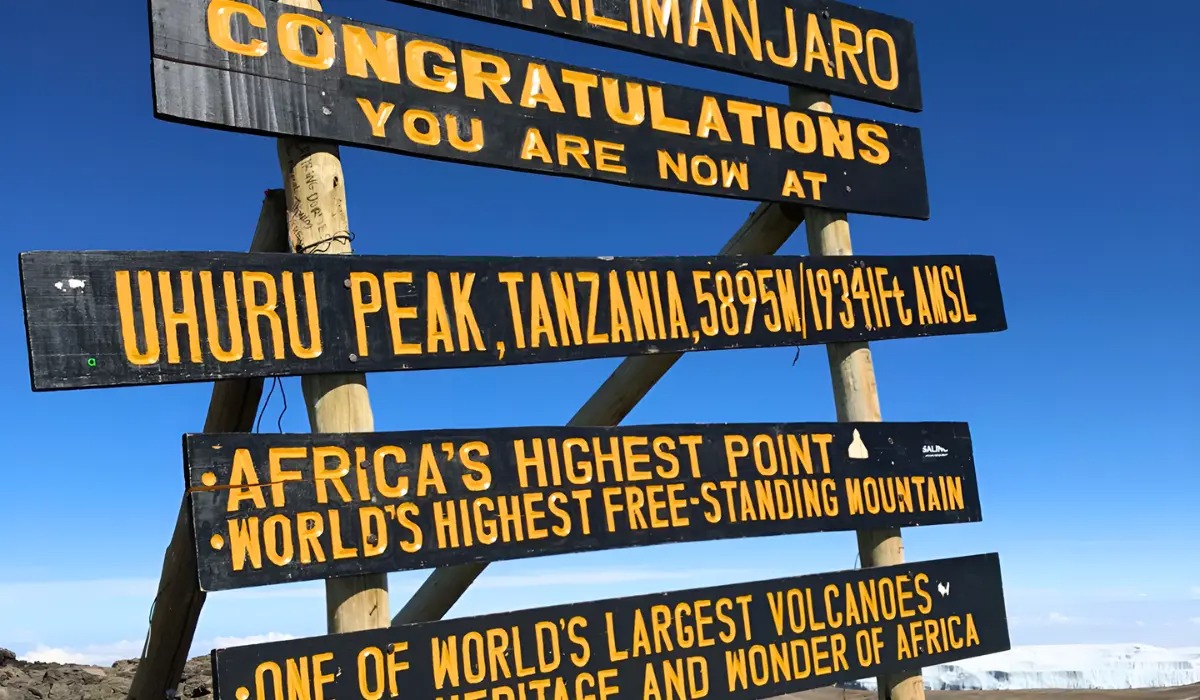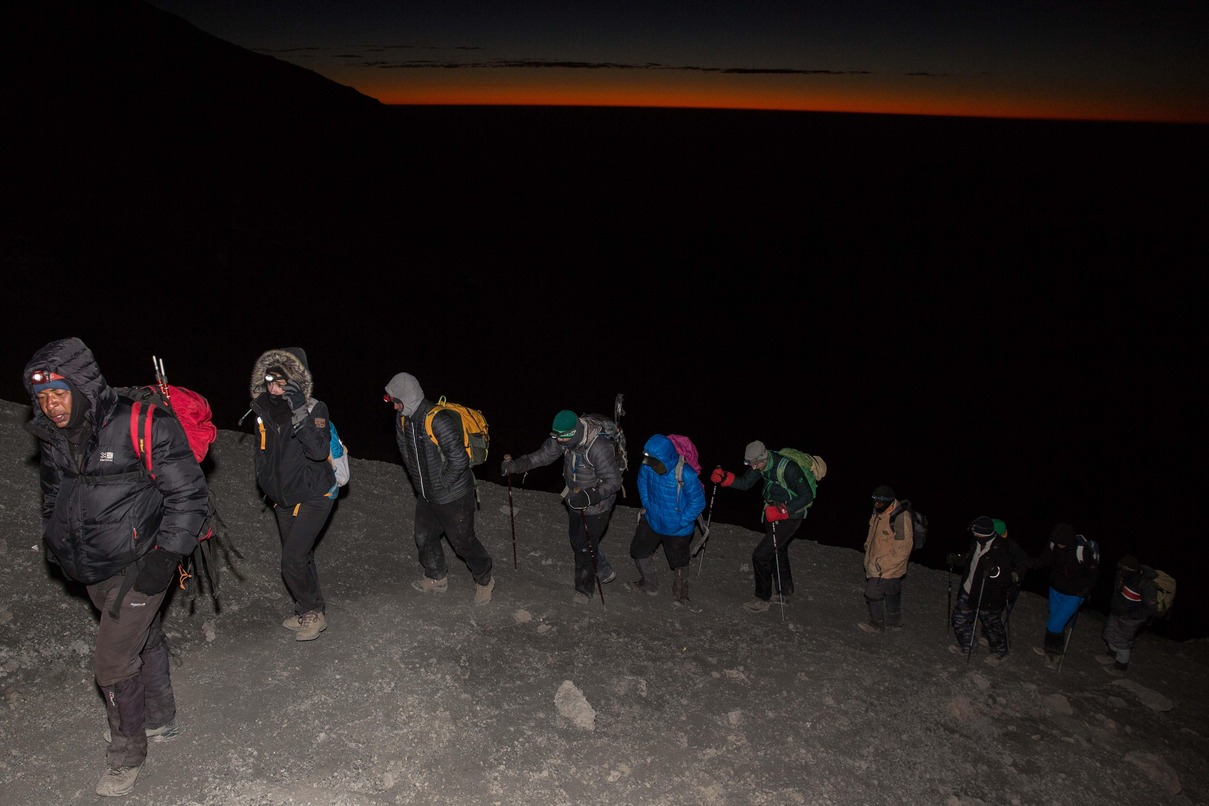Kilimanjaro’s arctic zone is a geological and climatic marvel, an icy enclave perched improbably near the equator. Beginning at 16,500 feet, it ascends to the summit, Uhuru Peak, where climbers encounter a world of biting winds, thin air (with oxygen levels nearly half those at sea level), and a panorama of ice and stone. Temperatures here swing dramatically, often hovering between 20°F and -20°F, while the landscape is a mosaic of snowfields, volcanic rubble, and the mountain’s famed glaciers, such as the Furtwängler and Rebmann—relics of a once-vaster ice cap.
These glaciers are more than scenic wonders; they’re vital arteries, channelling meltwater to the lush forests and savannahs below, sustaining both nature and human life. Vegetation is rare, limited to tenacious lichens and algae that speckle the rocks, their colors a faint defiance against the monochrome expanse. Insects, too, have carved out a niche, their physiology fine-tuned to the cold. The soil, a gritty blend of volcanic ash and scree, tells a story of Kilimanjaro’s fiery past, its eruptions long silenced but ever-present in the terrain.
This zone’s equatorial setting makes it a rarity among arctic environments, a high-altitude anomaly that captivates scientists and adventurers alike. Its glaciers, some dating back millennia, are shrinking alarmingly, a poignant reminder of climate change’s reach even to this remote summit.
What Defines an Arctic Zone?
Arctic zones are remarkable biomes found not only at the Earth’s poles but also at lofty elevations in diverse climate regions, such as atop towering mountains like Kilimanjaro. These areas are sculpted by relentless cold, where temperatures frequently dive below freezing—on Kilimanjaro, ranging from 20°F to -20°F (-7°C to -29°C). Precipitation is scant and predominantly falls as snow, piling into glaciers, snowfields, and ice caps that dominate the terrain alongside rugged, barren rock.
Life in these zones is a study in resilience. Vegetation is minimal, with only the toughest species—such as mosses, lichens, and occasional algae—able to endure the harsh conditions. Larger plants and trees are absent, their growth thwarted by the frozen, nutrient-poor soil, often locked in permafrost at other arctic sites, though Kilimanjaro’s volcanic soil is more rocky than icy. Animal life is equally sparse, limited to a handful of specially adapted creatures like endemic insects that thrive in the cold. This low biodiversity underscores the severity of the environment, where survival demands exceptional adaptation.
The Global Role of Arctic Zones
Beyond their stark beauty, arctic zones are unsung heroes in Earth’s climate and hydrological systems. Their snow and ice act as planetary mirrors, reflecting sunlight through a process called the albedo effect. This reflection helps cool the globe by bouncing solar energy back into space, a critical mechanism for temperature regulation. On Kilimanjaro, the gleaming glaciers amplify this effect, standing out against the equatorial sun.
These zones also anchor the water cycle. As snow and ice melt—albeit slowly on Kilimanjaro—they release water that trickles down to nourish rivers, streams, and ecosystems at lower elevations. This runoff is a lifeline for the mountain’s surrounding communities and wildlife, especially in regions where water is scarce, highlighting the arctic zone’s far-reaching importance.
Moreover, in many arctic regions, permafrost traps vast reserves of carbon dioxide and methane, acting as a natural vault that curbs greenhouse gas emissions. While Kilimanjaro’s arctic zone lacks extensive permafrost due to its volcanic nature, its glaciers still contribute to carbon cycling indirectly by supporting ecosystems that sequester carbon lower down. Yet, this balance is precarious—rising global temperatures threaten to melt these icy stores, potentially unleashing stored gases elsewhere and diminishing Kilimanjaro’s reflective shield.
Conquering the Arctic Zone: Essential Tips for Climbers
For those scaling Kilimanjaro, the arctic zone is the crucible of the climb, a grueling finale that tests endurance, preparation, and spirit. The ascent often begins at high camp in the alpine desert, transitioning swiftly into this icy realm. The summit push—typically a midnight start—spans six to eight hours or more, plunging climbers into darkness, frigid cold, and relentless slopes. Here’s how to tackle it:
1. Master the Art of Layering
The arctic zone’s chill demands strategic clothing. Climbers should wear 4-6 layers on their upper body and 3 on their lower half. Start with a moisture-wicking base layer to keep sweat at bay, add insulating mid-layers (like fleece or down) to trap heat, and top it with a windproof, waterproof shell to fend off gales and snow. This system ensures warmth while allowing flexibility as conditions shift.
2. Rely on Trekking Poles
The steep, uneven terrain—littered with loose scree and icy patches—makes trekking poles indispensable. They provide stability, ease the load on weary legs, and help navigate the descent, where fatigue can turn a stumble into a fall.
3. Prioritize Hydration
Cold, dry air saps moisture through every breath, and the exertion of climbing amplifies dehydration—a silent aggravator of altitude sickness. Drink regularly, even without thirst, aiming for small sips during breaks. Water bladders may freeze, so opt for a sturdy bottle, stored upside down to keep the lid ice-free.
4. Shield Against the Sun
The summit night begins in darkness, but dawn unleashes fierce UV rays, intensified by snow’s reflection. Apply high-SPF sunscreen at the peak before descending, and don sunglasses to protect against snow blindness—a real risk at this altitude.
5. Equip with Gaiters
While optional, gaiters are a climber’s ally, barring volcanic dust and scree from infiltrating boots and pants. This small addition boosts comfort, especially on the dusty, gravelly descent.
6. Acclimatize Wisely
Altitude sickness looms large in the arctic zone, where oxygen is scarce. Ascend gradually over days, heeding your body’s signals. Mild headaches or fatigue are common, but severe symptoms—nausea, dizziness, or confusion—demand an immediate retreat. Routes like Machame or Lemosho, with their longer itineraries, aid acclimatization, enhancing your summit odds.
The summit night is a marathon of willpower, with popular trails like the Marangu or Rongai routes funneling climbers through this zone. Preparation is everything—mental fortitude, paired with these practical steps, turns the dream of Uhuru Peak into reality.
Conservation: A Race Against Melting Ice
Kilimanjaro’s arctic zone is a fragile jewel, its glaciers retreating at an alarming pace under the weight of global warming. Once sprawling across the summit, these ice fields have dwindled, with projections suggesting they could vanish within decades. This loss isn’t just aesthetic—it jeopardizes the water supply for ecosystems and communities below, erodes the mountain’s albedo effect, and signals broader climate upheaval.
Efforts to stem this tide are underway. Researchers monitor glacial retreat, tracking changes to inform global climate models, while sustainable climbing practices—minimizing waste, reducing carbon footprints—gain traction among operators and adventurers. Yet, the prognosis remains grim; many experts believe the ice cap’s fate is sealed unless global emissions drop sharply. Preserving this zone is a mission for science, policy, and every climber who treads its slopes, a call to safeguard a natural wonder for generations yet to come.


